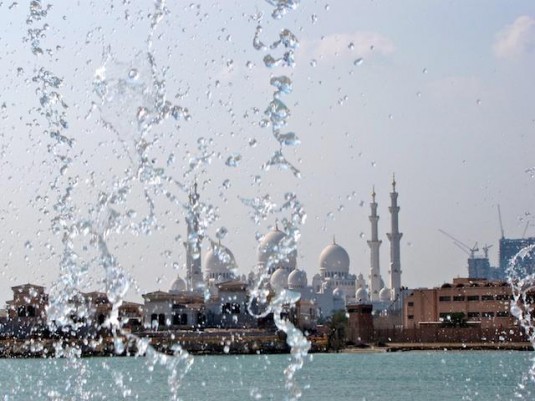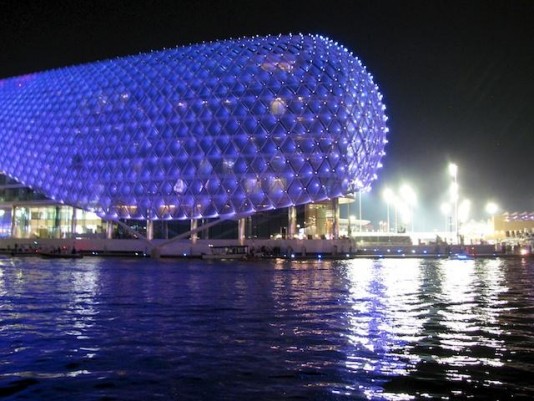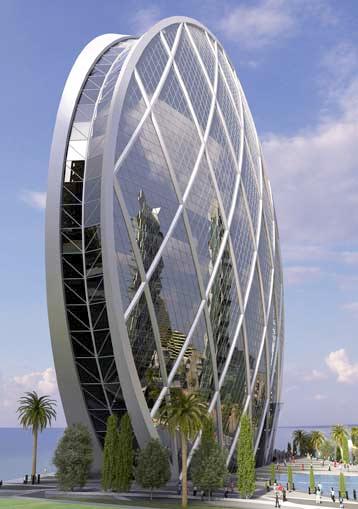The oil-rich Emirates seek opportunities in manufacturing, aerospace, building and infrastructure. Kathleen Maher reports from the new center of investment.
By Kathleen Maher
Editor-in-Chief
Abu Dhabi has been described by some as the ant to Dubai’s grasshopper. Dubai grew fast and it grew flashy with big investments in real estate and tourism. Meanwhile Abu Dhabi, the capital of the United Arab Emirates, has been more measured in its use of its huge reserves of money from the petroleum industry. Thus, when Dubai was hard hit by the economic collapse of 2008, it was Abu Dhabi which bailed out the Emirate; the names of many of Dubai’s iconic buildings have been changed to reflect the shift. Most pointedly the mega skyscraper Burj Dubai has become Burj Khalifa after Sheikh Khalifa bin Zayed al Nahyen.

Lately though, Abu Dhabi is coming to resemble its flashy cousin. The city skyline is dominated by cranes over the city as it builds its own new skyscrapers and hustles to provide housing for an influx of new workers being recruited to help build new business in the Emirate.
Outside of the city, Abu Dhabi has built resort hubs. The flashy Yas Island boasts one of Abu Dhabi’s first theme parks, the enormous Ferrari World, which features the world’s fastest roller coaster. Yas Island has a cluster of hotels built around one of the world’s 19 Formula 1 race tracks. The race track winds under and around the Yas Hotel. There are new residential, resort and cultural complexes going up on Saadiyat Island including the Zayed Cultural Museum, and Abu Dhabi bases for the Guggenheim and Louvre museums. Al Raha Beach is a preferred site for shiny, new office buildings.

Downtown Abu Dhabi looks like Berlin a decade ago. The skyline is dominated by cranes and half-built buildings but there’s a big difference too. Many of the dusty streets down below have no street signs, or the names of the streets on signs are not the names that people commonly call the streets. Abu Dhabi is changing its system to a numbered grid system but people tend to call streets by their older, more familiar names. Cabs are inexpensive and plentiful, so are private cars and drivers, but no one seems to really know how to get anywhere. Drivers seem to stay continuously on the phone getting directions from some higher authority. Mysteriously, drivers stop the car to confer with other drivers, sometimes seemingly calling spontaneous conferences with five and six drivers on a street corner. This new town that Abu Dhabi is building is outrunning its infrastructure and outpacing its history.
New business
The UAE is a kingdom, not a democracy. The leader of Abu Dhabi, Sheikh Khalifa bin Zayed al Nahyen, is the President of the UAE. He became king after the death of his father Sheikh Zayed al Nahyen in 2004. The son is following the example of his father who built the UAE after the country achieved independence in 1971. Zayed oversaw the rise of Abu Dhabi from a small country which depended on the pearl industry before the arrival of cultured pearls threatened Abu Dhabi’s economy. Oil came along in 1958 to save Abu Dhabi, and let to Zayed becoming king, replacing his brother Sheikh Shakbut bin Sultan al Nahyen, because of his vision of what oil could do for the region.
Sheikh Zayed supported cooperation among the nearby Arab states in a loose union called the GCC, Gulf States Cooperation Council. The UAE has managed to become the relatively serene equivalent of Switzerland in the stormy Middle East through a policy of generosity towards its neighbors and religious tolerance. With peace comes prosperity or maybe with prosperity comes peace. Either way, money makes everything easier—Abu Dhabi is sitting on 10% of the world’s oil reserves.
The country is not content to trust its future to the oil business and the Sheikh Khalifa is eager to push the country forward even further and faster than his father did. It is almost as if Zayed started the job and Khalifa took the baton running. He has mounted a campaign to diversify industry in the UAE, to attract new business, and to invest and build homegrown businesses in the region. Tourism has gotten a boost with the relaxation of restrictions against alcohol and foreign investment has been encouraged with policies allowing foreign investment, and tax breaks for new businesses. A progressive, the Sheikh is calling for the establishment of sustainable business and the empowerment of all of the regions potential workforce—this means women.
Women in the UAE have a choice about whether to wear the encompassing Abaya and the veil called the Sheylah and many do, but others are comfortable with just head scarves and others still appear in jeans, skirts, business suits, and hair flying free. It should also be said that Arab women know how to work an Abaya. In the UAE, the gowns are almost always black but there’s a lot of variation in ornamentation, cut, and fabric and the look can be chic and glamorous if that’s the game plan.
Many men in the UAE wear white robes and the head dress anchored by a rope circlet. The rope, is a reference to the people’s Bedouin heritage, the circlet opened up into a figure eight become a dandy hobble for keeping a camel close by. Likewise, women’s veils, also helped protect against blowing sand storm. History is something that’s never forgotten. The question is, how much of a role does it play in the future?
Following the money
Mubadala is an investment company that helps put together capital for the emirate’s ambitions. It’s headed by Sheikh Khalifa Al Nahyan with a solid brain trust of executives from all over the world. The group funds and empowers spin-off companies to build business for Abu Dhabi.
The UAE might not be a democracy, but it is a land of opportunity. Mubadala has developed a long-range plan called Abu Dhabi 2030 and it calls for new business development in non-oil related areas such as semiconductors, energy, health care, aeronautics, education, and finance. One of the core principals is to build sustainable business. And if you look at the list, it almost seems as if the region is choosing the hardest problems to tackle.
That’s not an accident. Mubadala’s executives have a stated philosophy they call patient capital. Roughly stated, it goes like this: if you’re rich, you’ve got time. They’re intentionally picking tough problems to solve because they figure they’ll win where others, with fewer resources will eventually flag and fall behind.
ATIC (Advanced Technology Investment Company) has become one of the most well known of Mubadala’s spin offs. It is the largest foreign manufacturing employer in the United States. To American observers, the company seemingly came from no where and saved AMD’s bacon. It turned profitless AMD into profitable AMD with investment into AMD’s fabs and the foundation of GlobalFoundries; AMD and ATIC are partners in the fab with ATIC being the majority shareholder. Eventually, AMD plans to become completely fabless. It’s already become considerably more profitable without the burden of a ravenous and merciless fab business. As part of the deal, ATIC is continuing AMD’s relationship with IBM for process technology; among the first announcements of the new company was a new fab for Malta, New York, which is expected to bring 6,000 jobs to the region. The company has continued its march with the acquisition of Charter. So now the company has major fabs in Dresden and Singapore, the new fab in Malta, and they’re planning to build a fab at home in Abu Dhabi. Based on the Malta model, ATIC hopes to build 6,000 new jobs in Abu Dhabi.
ATIC recently hosted a Semiconductor Summit, a lavish affair designed to function both as a show of strength and commitment, as well as a friendly overture to potential customers and even competitors. As invited guests of ATIC, JPR got a first hand view of ATIC’s and Abu Dhabi’s grand vision. Ibrahim Ajami, the young, competitive CEO of ATIC stated repeatedly and emphatically, “we’re in this to win.” His point was that yes, there’s substantial funding behind ATIC but it is not a hobby, it is a business.
GlobalFoundries is already the third largest fab company in the world and, with leader TSMC of Taiwan clearly in its sites, it hopes to move up. It’s all about patient capital. Fabs cost a lot of money to build and it takes time to get them humming—this, says Ajami, is the source of ATIC’s strength. Abu Dhabi has money, lots of money, enough money, maybe, to ride out a few more boom and bust cycles than the competition.
ATIC Chairman of the Board Whaleed Al Muhairi also spoke at the conference. In his other role as COO of Mubadala, Whaleed is one of the main architects of the grand vision that is Abu Dhabi 2030. Al Muhairi says the world needs second sources so why shouldn’t businesses in the UAE be those second sources. For example, GlobalFoundries can function as a second source fab for companies that already have their own fabs and in fact, Chartered is very comfortable in this role.
As another example, Abu Dhabi has aggressively addressed the aerospace industry. It’s modus operandi has been similar to the way in which it has built GlobalFoundries. Mubadala has acquired a controlling interest in SR Technics, an aeronautics service and components company based in Zurich, Switzerland and it has founded the Abu Dhabi Aircraft Technologies (ADAT) company. These two MRO (maintenance, repair, and overhaul companies) are the first point of contact for Abu Dhabi’s aerospace ambitions, which include engineering, R&D, and manufacture for the future. Mubadala is building Strata, a new composites aerostructures plant and plans to be operational by the end of 2010. Strata has partnered with EADS, Airbus, FACC, and Alenia Aeronautica, which are establishing manufacturing programs at the plant.

On the building side, Mubadala has funded ALDAR, a construction company that is responsible for many of the cranes flying over Adu Dhabi. It built the indescribably huge Ferrari World and much of the infrastructure around Yas Island. ALDAR is building its own headquarters, in the simply named HQ building at nearby at Al Raha Beach. The building, a unique round building supported by an exoskeleton that allows open space inside the building will serve as the new headquarters for ATIC and GlobalFoundries as well as ALDAR.
It is being built by Arup. Arup’s engineers have said that this project was developed and constructed on an extremely short time frame requiring close interaction between the design teams and construction teams. Another project funded by Mabadala in the region, Masdur City, is an entire city being built to be sustainable using renewable energy with zero carbon and zero waste. It’s being designed by Foster + Partners of London. Partners include Consensus Business Group, Credit Suisse and Siemens Venture Capital. CH2M Hill has been hired for the first phase of construction along with the Al Jaber Group for infrastructure construction. Both Autodesk and Bentley are actively involved in key projects. Bentley Systems is working with CH2M Hill. Autodesk is working with Adrian Smith + Gordon Gill Architecture in the design of Masdar City’s Headquarters. Both companies have been talking up the project as showcases for their BIM products.
And, continuing the strategy of yoking education with building, the Masdar City project will be home to MIST, Masdar Institute of Science and Technology, which is being developed in conjunction with MIT.
These grand projects have felt the effects of the recession. The Masdar City project has been delayed and Phase 1 will not be completed until 2015 instead of 2009 as originally hoped. Eventually, it is hoped Masdar City will pay for itself and start returning on its investment.
Aldar also suffered in the real estate conflagration of 2009. The group is hoping to see an influx of some of that patient capital from the Abu Dhabi government to help it over some rough spots. Aldar’s major projects are set to start returning on their investments including some of the Yas Island facilities, the HQ building, luxury villas, and Ferrari World.
In order to build a new workforce, Mubadala has established ADEC (the Abu Dhabi Education Council), yet another piece of the puzzle, founded to build education resources in Abu Dhabi. The Education Council will forge links between the business and education community to create an educated elite of people in Abu Dhabi who can continue the growth and development of Abu Dhabi into the future.
Abu Dhabi’s diversification plan is already paying off. Mubadala reports that in 2008 revenues from oil and gas assets accounted for 23.1% of their total asset base. In 2009, that percentage dropped to 15.5% and the company intends to push that trend. Aerospace is the fastest growing segment for the company.
Among the grand ideas that were being floated around at the Summit was that Abu Dhabi and the UAE can become a magnet for R&D and investment—an intellectual counterbalance to China, India, and the West. The region is fostering business development from outside with tax breaks and light restriction and has ambitions to become a major distribution hub for the region in much the same way that The Netherlands fulfills that role for Europe. Abu Dhabi is not just motivated by money either. Speakers at the summit including former counter terrorism advisor to George W. Bush Richard Clark and Ambassador Richard Olson said that success for the UAE and for Abu Dhabi 2030 has the potential to bring stability to the region.
The IMF notes that investment by the GCC (including the UAE, Bahrain, Kuwait, Oman, Saudi Arabia, and Qatar) continued through the recession and has left the region poised for growth in the future. Throughout the Middle East, unemployment remains a serious challenge with implications for peace in the region as well as economic growth.
Impatient Human Capital
In addition to oil, says Al Muhairi, the country is rich in human resources. The country already spends a lot of money educating its people. Young Emiratis have been going overseas for their education and when they come back they come back with cultural fluency, they speak English and other languages, and they’re looking for opportunities.
Ibrahim Ajami told people “I’m doing this because when I grew up here, there was nothing to do.”
What is screamingly obvious throughout our visit to the region was that most of the people working on the vision of Abu Dhabi 2030 are young. Like Sheikh Khalifa, many grew up at a time when their country dramatically changed from an area of small, often poor communities, and became rich beyond imagining.
They’re setting about building a country the way they want to see it and they’re seeing the future through the eyes of a young wealthy populace. Some of the most impressive new projects are theme parks, shopping malls, outlandish hotels, and race tracks. A favorite entertainment still seems to be dune bashing. It involves riding out into the desert with dune buggies, SUVs with semi-deflated tires, motorcycles, and slip-sliding over the dunes.
The ant labors on as well: the investments in semiconductors, aerospace, worldwide construction, universities, and global finance are building a strong hedge against the dependence on one volatile industry—petroleum.
It’s easy to get enthusiastic about the future of Abu Dhabi after visiting the country and talking to the people who are working on the future. “It’s nation building,” one man told me, flatly. He wasn’t daunted, though, he was thrilled. Can it really be this easy? Can education, wealth, and enthusiasm be enough to write a new history for a country?
For all the region’s insistence on looking forward and building new skyscrapers where small villages once stood, there are still old traditions and laws. Places like Yas Island with snazzy hotel night clubs and disco boats blasting music can feel almost like reserves where the tourists can be kept entertained and cloistered. It’s still hard to get a liquor license in most parts of Abu Dhabi. It would be a really bad idea to go off the reservation and get caught misbehaving. Sharia law is still the legal foundation for the UAE. And, even though the region is going to continue to provide jobs to internationals, Abu Dhabi is one of the most expensive places in the world to live.
This generation of people in their 30s and 40s eager to get their country moving have to figure out ways to blend cultures, to build a society that can accommodate different classes. But, to talk to the people who are busy building their country, there is nothing they can’t do. They’ve got money and they’ve got time. What more do you need?





